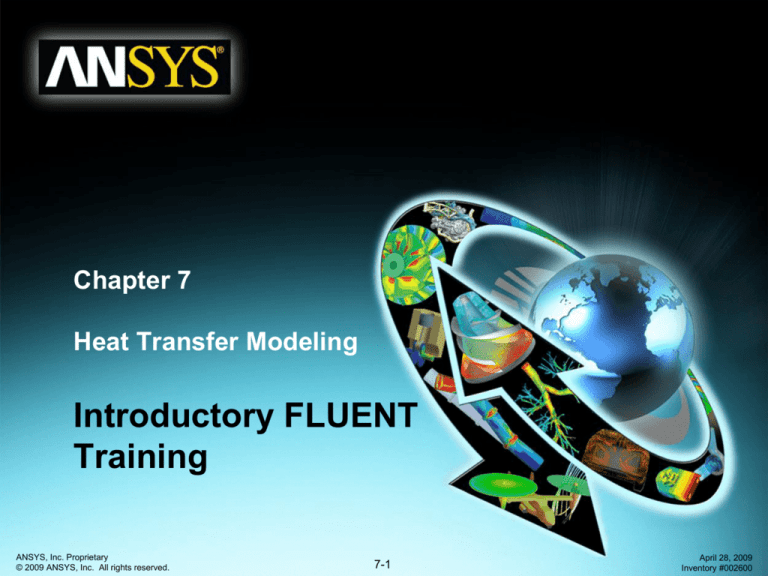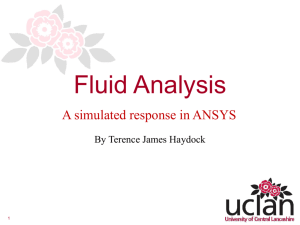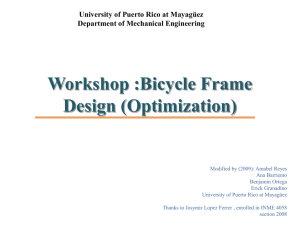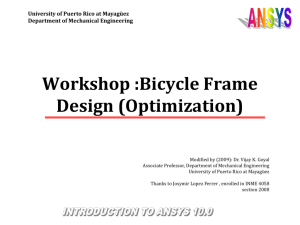
Chapter 7
Heat Transfer Modeling
Introductory FLUENT
Training
ANSYS, Inc. Proprietary
© 2009 ANSYS, Inc. All rights reserved.
7-1
April 28, 2009
Inventory #002600
Heat Transfer Modeling
Outline
Training Manual
• Energy Equation
• Wall Boundary Conditions
• Conjugate Heat Transfer
• Thin and two-sided walls
• Natural Convection
• Radiation Models
• Reporting - Export
ANSYS, Inc. Proprietary
© 2009 ANSYS, Inc. All rights reserved.
7-2
April 28, 2009
Inventory #002600
Heat Transfer Modeling
Energy Equation – Introduction
Training Manual
• Energy transport equation:
Unsteady
Conduction
Conduction
Species
Diffusion
Viscous
Dissipation
Enthalpy
Source/Sink
– Energy E per unit mass is defined as:
– Pressure work and kinetic energy are always accounted for with
compressible flows or when using the density-based solvers. For the
pressure-based solver, they are omitted and can be added through the
text command:
– The TUI command define/models/energy? Will give more options
when enabling the energy equation.
ANSYS, Inc. Proprietary
© 2009 ANSYS, Inc. All rights reserved.
7-3
April 28, 2009
Inventory #002600
Heat Transfer Modeling
Energy Equation for Solid Regions
Training Manual
• Ability to compute conduction of heat through solids
• Energy equation:
– h is the sensible
enthalpy:
• Anisotropic conductivity
in solids (pressure-based
solver only)
ANSYS, Inc. Proprietary
© 2009 ANSYS, Inc. All rights reserved.
7-4
April 28, 2009
Inventory #002600
Heat Transfer Modeling
Wall Boundary Conditions
Training Manual
• Five thermal conditions
– Heat Flux
– Temperature
– Convection – simulates an external convection environment which is not
modeled (user-prescribed heat transfer coefficient).
– Radiation – simulates an external radiation environment which is not
modeled (user-prescribed
external emissivity and
radiation temperature).
– Mixed – Combination of
Convection and Radiation
boundary conditions.
• Wall material and thickness
can be defined for 1D or
shell conduction calculations.
ANSYS, Inc. Proprietary
© 2009 ANSYS, Inc. All rights reserved.
heat transfer calculations.
7-5
April 28, 2009
Inventory #002600
Heat Transfer Modeling
Conjugate Heat Transfer
Training Manual
• In CHT, heat conduction in solid regions is coupled to convective
heat transfer in fluid regions.
• Makes use of the Coupled boundary condition on wall zones which
define fluid/solid interfaces.
Grid
Velocity Vectors
Temperature Contours
Coolant Flow Past Heated Rods
ANSYS, Inc. Proprietary
© 2009 ANSYS, Inc. All rights reserved.
7-6
April 28, 2009
Inventory #002600
Heat Transfer Modeling
Conjugate Heat Transfer Example
Training Manual
Air outlet
Symmetry
Planes
Top wall
(externally cooled)
h = 1.5 W/m2∙K
T∞ = 298 K
Electronic Component
(one half is modeled)
k = 1.0 W/m∙K
Heat generation rate of 2
watts (each component)
Air inlet
V = 0.5 m/s
T = 298 K
ANSYS, Inc. Proprietary
© 2009 ANSYS, Inc. All rights reserved.
Circuit board (externally cooled)
k = 0.1 W/m∙K
h = 1.5 W/m2∙K
T∞ = 298 K
7-7
April 28, 2009
Inventory #002600
Heat Transfer Modeling
Problem Setup – Heat Source
Training Manual
• An energy (heat) source is added to the solid zone to simulate the
heat generation by the heat-generating electronic components.
ANSYS, Inc. Proprietary
© 2009 ANSYS, Inc. All rights reserved.
7-8
April 28, 2009
Inventory #002600
Heat Transfer Modeling
Temperature Distribution (Front and Top View)
Temp.
(ºF)
426
Flow
direction
Air (fluid zone)
Front View
Training Manual
Convection boundary
1.5 W/m2 K
298 K free stream temp
410
394
378
Board
(solid zone)
362
346
330
Flow
direction
Elect. Component
(solid zone)
2 Watts source
Convection Boundary
1.5 W/m2 K
298 K free stream temp.
Top View
(image mirrored about symmetry plane)
314
298
ANSYS, Inc. Proprietary
© 2009 ANSYS, Inc. All rights reserved.
7-9
April 28, 2009
Inventory #002600
Heat Transfer Modeling
Alternate Modeling Strategies
Training Manual
• An alternate treatment of the board surface would be to model it as a
wall with specified thickness (Thin Wall model).
• In this case, there is no need to mesh the lower solid zone
(representing the board).
ANSYS, Inc. Proprietary
© 2009 ANSYS, Inc. All rights reserved.
7-10
April 28, 2009
Inventory #002600
Heat Transfer Modeling
Meshed Wall vs. Thin Wall Approach
Training Manual
• Meshed wall approach
–
–
–
–
Energy equation is solved in a solid zone representing the wall.
Wall thickness must be meshed.
This is the most accurate approach but requires more meshing effort.
Always uses the coupled thermal boundary condition since there are
cells on both sides of the wall.
Fluid zone
Wall zone
(with shadow)
Solid zone
Wall thermal resistance directly accounted for in the
Energy equation; Through-thickness temperature
distribution is calculated.
Bidirectional heat conduction is calculated.
ANSYS, Inc. Proprietary
© 2009 ANSYS, Inc. All rights reserved.
7-11
April 28, 2009
Inventory #002600
Heat Transfer Modeling
Meshed Wall vs. Thin Wall Approach
Training Manual
• Thin wall approach
– Artificially models models the thermal resistance of the wall.
– Necessary data is supplied through wall boundary conditions (material
conductivity and thickness).
– Uses the coupled thermal boundary condition only for internal walls.
Fluid zone
Wall zone
(no shadow)
Wall thermal resistance is calculated using artificial
wall thickness and material type. Through-thickness
temperature distribution is assumed to be linear.
Conduction is only calculated in the wall-normal
direction unless Shell Conduction is enabled.
ANSYS, Inc. Proprietary
© 2009 ANSYS, Inc. All rights reserved.
7-12
April 28, 2009
Inventory #002600
Heat Transfer Modeling
Shell Conduction Option
Training Manual
• The shell conduction option is used to enable in-plane conduction
calculations.
• Additional conduction cells
are created but cannot be
displayed and cannot be
accessed by
UDFs.
• Solid properties of the
conduction zones must be
constant and cannot be
temperature-dependent.
Static Temperature
(cell value)
Virtual conduction cells
ANSYS, Inc. Proprietary
© 2009 ANSYS, Inc. All rights reserved.
7-13
April 28, 2009
Inventory #002600
Heat Transfer Modeling
Natural Convection
Training Manual
• Natural convection occurs when heat
is added to fluid and fluid density
varies with temperature.
• Flow is induced by force of gravity
acting on density variation.
• When gravity term is included,
pressure gradient and body force term
in the momentum equation are rewritten as:
where
• This pressure transformation avoids round off error when gravity is
enabled.
ANSYS, Inc. Proprietary
© 2009 ANSYS, Inc. All rights reserved.
7-14
April 28, 2009
Inventory #002600
Heat Transfer Modeling
Natural Convection – the Boussinesq Model
Training Manual
• Boussinesq model assumes the fluid density is uniform except for the body
force term in the momentum equation along the direction of gravity, we have:
– Valid when density variations are small (i.e., small variations in temperature).
• The Boussinesq approximation provides improved convergence for many
natural convection flows than by using fluid density as function of
temperature.
– Constant density assumptions reduces nonlinearity.
– Suitable when density variations are small.
– Cannot be used together with species transport or reacting flows.
• Natural convection problems inside closed domains:
– For steady-state solver, Boussinesq model must be used.
– For unsteady solver, Boussinesq model or ideal gas law can be used.
ANSYS, Inc. Proprietary
© 2009 ANSYS, Inc. All rights reserved.
7-15
April 28, 2009
Inventory #002600
Heat Transfer Modeling
User Inputs for Natural Convection
Training Manual
• Define the gravitational acceleration – done
in Operating Conditions panel.
• Define density model (several options
are available).
– Boussinesq model
• Enable gravity.
• Set Operating Temperature, T0.
• Select Boussinesq as the Density
Method and assign constant
value, ρ0.
• Set Thermal Expansion
Coefficient, β.
– If using a temperature dependent
model (ideal gas, AungierRedlich-Kwong, polynomial):
• Specify Operating Density or,
• Allow FLUENT to calculate ρ0
from a cell average (default,
every iteration).
ANSYS, Inc. Proprietary
© 2009 ANSYS, Inc. All rights reserved.
7-16
April 28, 2009
Inventory #002600
Heat Transfer Modeling
Radiation
Training Manual
• Radiation effects should be accounted for when
is of
comparable magnitude as the convection and conduction heat transfer rates.
– σ is the Stefan-Boltzmann constant, 5.67×10-8 W/(m2·K4)
• To account for radiation, radiative intensity transport equations (RTEs) are
solved.
– Local absorption by fluid and at boundaries couples these RTEs with the energy
equation.
– These equations are often solved separate from the fluid flow solution; however,
they can be coupled to the flow.
• Radiation intensity, I(r,s), is directionally and spatially dependent.
• Five radiation models are available in FLUENT
(see the Appendix for details on each model).
–
–
–
–
–
Discrete Ordinates Model (DOM)
Discrete Transfer Radiation Model (DTRM)
P1 Radiation Model
Rosseland Model
Surface-to-Surface (S2S)
ANSYS, Inc. Proprietary
© 2009 ANSYS, Inc. All rights reserved.
7-17
April 28, 2009
Inventory #002600
Heat Transfer Modeling
Selecting a Radiation Model
Training Manual
• Some general guidelines for
radiation model selection:
– Computational effort
• P1 gives reasonable accuracy
with the least amount of effort.
– Accuracy
• DTRM and DOM are the most
accurate.
– Optical thickness
• Use DTRM/DOM for optically thin
media (αL << 1)
• Use P1 for optically thick media.
• Use S2S for zero optical thickness.
– Scattering
• Scattering is accounted for only with P1 and DO.
– Particulate effects
• P1 and DOM account for radiation exchange between gas and particulates.
– Localized heat sources
• DTRM/DOM with a sufficiently large number of rays/ ordinates is most appropriate.
ANSYS, Inc. Proprietary
© 2009 ANSYS, Inc. All rights reserved.
7-18
April 28, 2009
Inventory #002600
Heat Transfer Modeling
Summary
Training Manual
• A number of intermediate and advanced tutorials are available at the
FLUENT User Services Center:
www.fluentusers.com/fluent/training/intermediate/tutorials/index.htm
• Other learning resources
– Advanced training course in heat transfer offered by FLUENT
– Web-based training modules
– User Services Center, www.fluentusers.com
• All tutorials and lecture notes
• User Documentation
ANSYS, Inc. Proprietary
© 2009 ANSYS, Inc. All rights reserved.
7-19
April 28, 2009
Inventory #002600
Appendix
ANSYS, Inc. Proprietary
© 2009 ANSYS, Inc. All rights reserved.
7-20
April 28, 2009
Inventory #002600
Heat Transfer Modeling
Solar Load Model
Training Manual
• Solar load model
– Ray tracing algorithm for solar radiant
energy transport: Compatible with all
radiation models
– Available with parallel solver (but ray
tracing algorithm is not parallelized)
– 3D only
• Specifications
– Sun direction vector
– Solar intensity (direct, diffuse)
– Solar calculator for calculating
direction and direct intensity using
theoretical maximum or “fair weather
conditions”
– Transient cases
• When direction vector is specified with
solar calculator, sun direction vector will
change accordingly in transient
simulation
• Specify “time steps per solar load
update”
ANSYS, Inc. Proprietary
© 2009 ANSYS, Inc. All rights reserved.
7-21
April 28, 2009
Inventory #002600
Heat Transfer Modeling
Energy Equation Terms – Viscous Dissipation
Training Manual
• Energy source due to viscous
dissipation:
– Also called viscous heating.
– Important when viscous shear in
fluid is large (e.g. lubrication)
and/or in high-velocity
compressible flows.
– Often negligible
• Not included by default in the
pressure-based solver.
• Always included in the densitybased solver.
– Important when the Brinkman
number approaches or exceeds
unity:
ANSYS, Inc. Proprietary
© 2009 ANSYS, Inc. All rights reserved.
7-22
April 28, 2009
Inventory #002600
Heat Transfer Modeling
Energy Equation Terms – Species Diffusion
Training Manual
• Energy source due to species
diffusion included for multiple
species flows.
– Includes the effect of enthalpy
transport
due to species diffusion
– Always included in the densitybased solver.
– Can be disabled in the pressurebased solver.
ANSYS, Inc. Proprietary
© 2009 ANSYS, Inc. All rights reserved.
7-23
April 28, 2009
Inventory #002600
Heat Transfer Modeling
Energy Equation Terms – Source Terms
Training Manual
• Energy source due to chemical reaction is included for reacting
flows.
– Enthalpy of formation of all species.
– Volumetric rate of creation of all species.
• Energy source due to radiation includes radiation source terms.
• Interphase energy source:
– Includes heat transfer between continuous and discrete phase
– DPM, spray, particles…
ANSYS, Inc. Proprietary
© 2009 ANSYS, Inc. All rights reserved.
7-24
April 28, 2009
Inventory #002600
Heat Transfer Modeling
Temperature Definitions for Thin Wall Model
Training Manual
• Thin wall model applies normal conduction only (no in-plane
conduction) and no actual cells are created.
• Wall thermal boundary condition is applied at the outer layer
Static temperature
(cell value)
Wall temperature
(outer surface)
Thin wall
(no mesh)
Wall temperature
(inner surface)
Thermal boundary
condition on wall
ANSYS, Inc. Proprietary
© 2009 ANSYS, Inc. All rights reserved.
7-25
April 28, 2009
Inventory #002600
Heat Transfer Modeling
Thin and Two-Sided Walls
•
•
•
•
Training Manual
In the Thin Wall approach, the wall thickness is not explicitly meshed.
Model thin layer of material between two zones
Thermal resistance x/k is artificially applied by the solver.
Boundary conditions specified on the outside surface.
Interior wall
(user-specified
thickness)
Exterior wall
(user-specified
thickness)
Interior wall shadow
(user-specified
thickness)
Outer surface
(calculated)
q1 or T1
Inner surface
(thermal boundary
condition specified
here)
Fluid or
solid
cells
x
q2 or T2
Fluid or
solid
cells
Thermal boundary conditions are
supplied on the inner surface of a thin
wall
ANSYS, Inc. Proprietary
© 2009 ANSYS, Inc. All rights reserved.
k1
k2
Fluid or
solid
cells
Thermal boundary conditions are
supplied on the inner surfaces of
uncoupled wall/shadow pairs
7-26
April 28, 2009
Inventory #002600
Heat Transfer Modeling
Discrete Ordinates Model
Training Manual
• The radiative transfer equation is solved for a discrete number of
finite solid angles, σs:
Absorption
Emission
Scattering
• Advantages:
– Conservative method leads to heat balance for coarse discretization.
• Accuracy can be increased by using a finer discretization.
– Most comprehensive radiation model:
• Accounts for scattering, semi-transparent media, specular surfaces, and
wavelength-dependent transmission using banded-gray option.
• Limitations:
– Solving a problem with a large number of ordinates is CPU-intensive.
ANSYS, Inc. Proprietary
© 2009 ANSYS, Inc. All rights reserved.
7-27
April 28, 2009
Inventory #002600
Heat Transfer Modeling
Discrete Transfer Radiation Model (DTRM)
Training Manual
• Main assumption – Radiation leaving a surface element within a specified
range of solid angles can be approximated by a single ray.
• Uses a ray-tracing technique to integrate radiant intensity along each ray:
• Advantages:
– Relatively simple model.
– Can increase accuracy by increasing number of rays.
– Applies to wide range of optical thicknesses.
• Limitations:
– Assumes all surfaces are diffuse.
– Effect of scattering not included.
– Solving a problem with a large number of rays is CPU-intensive.
ANSYS, Inc. Proprietary
© 2009 ANSYS, Inc. All rights reserved.
7-28
April 28, 2009
Inventory #002600
Heat Transfer Modeling
P-1 Model
Training Manual
• Main assumption – The directional dependence in RTE is integrated
out, resulting in a diffusion equation for incident radiation.
• Advantages:
– Radiative transfer equation easy to solve with little CPU demand.
– Includes effect of scattering.
• Effects of particles, droplets, and soot can be included.
– Works reasonably well for applications where the optical thickness is
large (e.g. combustion).
• Limitations:
– Assumes all surfaces are diffuse.
– May result in loss of accuracy (depending on the complexity of the
geometry) if the optical thickness is small.
– Tends to overpredict radiative fluxes from localized heat sources or
sinks.
ANSYS, Inc. Proprietary
© 2009 ANSYS, Inc. All rights reserved.
7-29
April 28, 2009
Inventory #002600
Heat Transfer Modeling
Surface-to-Surface (S2S) Radiation Model
Training Manual
• The surface-to-surface radiation model can be used for modeling
radiation in situations where there is no participating media.
– For example, spacecraft heat rejection system, solar collector systems,
radiative space heaters, and automotive underhood cooling.
– S2S is a view-factor based model.
– Non-participating media is assumed.
• Limitations:
– The S2S model assumes that all surfaces are diffuse.
– The implementation assumes gray radiation.
– Storage and memory requirements increase very rapidly as the number of
surface faces increases.
• Memory requirements can be reduced by using clusters of surface faces.
– Clustering does not work with sliding meshes or hanging nodes.
– Not to be used with periodic or symmetry boundary conditions.
ANSYS, Inc. Proprietary
© 2009 ANSYS, Inc. All rights reserved.
7-30
April 28, 2009
Inventory #002600
Heat Transfer Modeling
Export – ANSYS
•
Training Manual
The file written is an ANSYS results file with a .rfl extension. To
read this file into ANSYS, use the following procedure:
1. In ANSYS, go to General Postproc Data and File Options and read the
file generated from FLUENT.
2. Go to Results Summary and click on the first line in the upcoming panel.
You will see some information listed in the ANSYS_56_OUTPUT window
displaying geomtery information.
3. In the small ANSYS Input window, enter the following commands in
order:
SET,FIRST
/PREP7
ET,1,142
The last command corresponds to FLOTRAN 3D element. If your case is
2D, then this should be replaced by ET,1,141.
4. In the ANSYS MULTIPHYSICS UTITLITY menu, select Plot and then
Nodes or Elements, including the nodal solution under Results in the
drop-down list.
ANSYS, Inc. Proprietary
© 2009 ANSYS, Inc. All rights reserved.
7-31
April 28, 2009
Inventory #002600
Heat Transfer Modeling
Export – ANSYS
Training Manual
• Export ANSYS file through GUI or TUI:
/file/export/ansys file-name
• A single file will be written
containing coordinates,
connectivity, and the scalars
listed below:
– Density, viscosity
– X, Y, Z velocity, pressure,
temperature
– Turbulence kinetic energy,
turbulence dissipation rate,
turbulent viscosity, effective
viscosity
– Thermal conductivity (laminar, turbulent, effective)
– Total pressure and temperature, pressure coefficient, Mach number,
stream function, heat flux, heat transfer coefficient, wall shear stress,
specific heat
ANSYS, Inc. Proprietary
© 2009 ANSYS, Inc. All rights reserved.
7-32
April 28, 2009
Inventory #002600
Heat Transfer Modeling
Export – ABAQUS
Training Manual
• A single file (e.g., file.aba) containing coordinates, connectivity,
optional loads, zone groups, velocity, and selected scalars will be
written. You can specify which scalars you want in the Functions to
Write list.
• Export of data to Abaqus is available only for 3D models and is valid
only for solid zones or for those surfaces that lie at the intersection of
solid zones.
• None of the fluid zone heat transfer properties will get exported
• Ideal only when you want to do some Fluid-Solid interface i.e., wall
analysis.
file/export/abaqus file-name list-of-surfaces () yes|no
list-of-scalars q
ANSYS, Inc. Proprietary
© 2009 ANSYS, Inc. All rights reserved.
7-33
April 28, 2009
Inventory #002600
Heat Transfer Modeling
Export to Other Formats
Training Manual
• NASTRAN/PATRAN: The best
approach.
• For ABAQUS, NASTRAN, and PATRAN,
select the Loads to be written (Force,
Temperature, and/or Heat Flux) to
analyze the structural stresses (fluid
pressure or thermal) in an FEA
program.
• Loads are written only on boundary
walls when the entire domain is
exported (i.e., if you select no
Surfaces).
ANSYS, Inc. Proprietary
© 2009 ANSYS, Inc. All rights reserved.
7-34
Format
Supported
Version
Abaqus
6.3
ANSYS
10
ASCII
n/
CGNS
2
NASTRA
N
2001
PATRAN
2001
TECPLOT
9
April 28, 2009
Inventory #002600
Heat Transfer Modeling
Reporting – Heat Flux
Training Manual
• Heat flux report:
– It is recommended that you
perform a heat balance check
so to ensure that your solution
is truly converged.
• Exporting Heat Flux Data:
– It is possible to export heat
flux data on wall zones
(including radiation) to a
generic file.
– Use the text interface:
file/export/custom-heat-flux
– File format for each selected face zone:
zone-name nfaces
x_f y_f z_f A
…
ANSYS, Inc. Proprietary
© 2009 ANSYS, Inc. All rights reserved.
Q
T_w
7-35
T_c
HTC
April 28, 2009
Inventory #002600
Heat Transfer Modeling
Reporting – Heat Transfer Coefficient
Training Manual
• Wall-function-based heat transfer coefficient
where cP is the specific heat, kP is the turbulence kinetic energy at point
P, and T* is the dimensionless temperature:
– Available only when the flow is turbulent and Energy equation is enabled.
– Alternative for cases with adiabatic walls.
ANSYS, Inc. Proprietary
© 2009 ANSYS, Inc. All rights reserved.
7-36
April 28, 2009
Inventory #002600




